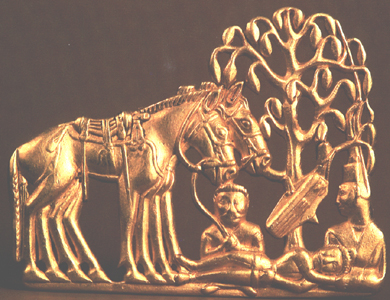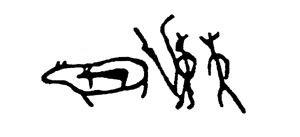
Siberia's Bronze and Iron age civilizations and their effect on the rest of the world

Along the shores of the North Pacific Coast, there were rich resources for the hunters and gatherers, continuous throughout the seasons of the year. The climate there was actually milder than today, since the lower sea levels caused by so much water trapped in the ice, meant that icy tundra stretched across what is now the Bering Straits from Chukotka to Alaska.
From at least 30,000 years ago the hunters and fishermen along what was then almost continously coastline, down the American coastline and over the centuries spread over the entire continent - then filled with big game animals. Except in the frozen north. Most of what is now Canada and the northern part of the USA was covered with ice - in places a mile thick.
Many similarities can be found between the American cultures - traditional decoration motifs, legends and beliefs etc. and those of Pacific cultures.
The technology of the people living in Yakutia then, is referred to as Neolithic, and has been called by archaeologists Yury Mochanov and his wife Svetlana, the Syatakh Culture. This technology is found all over North East Asia.
It is characterized by polished stone equipment, such as arrow heads, double-edged knives, scsrapers, adzes, burins (for piecing leather etc.)
They also had bone harpoons and there is evidence for fishing nets, and boats, although these organic remains, like the clothing, rarely survive.
They also had baked clay pottery containers etc. to use for cooking, storage and eating. Net-like decorations were pressed into the wet clay before firing.
Although fired clay figurines have been found in Eastern Europe dated back to the height of the ice age, the earliest remains of pottery vessels found so far date to about 15,000 years ago and have been found in Japan. So this useful technology may have spread from there. But much also depended on the availability of the materials, and also on a more settled lifestyle, since people moving on every few days would find pottery containers a bit too fragile.
Even though groups of people still moved in the course of the year and seasons, from place to place - it was usually a trail from and to the same places at the same times of the year.
Rock drawings can be found dating back to this time. (They can often be dated by the film of new material covering them). Although many drawings are not clear, some of them are more obviously showing rituals and mythical or celestial events. And the sites continued in use for thousands of years.
This is charaaterised by worked stone of many kinds, such as polished adzes, axes, scrapers, arrow heads, burins, fish-hollks, harpoons, needles.
Pottery was ornamented with a cord pattern or incised or imprinted with cut decoration.
The characteristic linked plate chain armour is now found, (the plates were originally and in places short of metal, bone) indicating that war-fare had become well organised with large bands of well-equipped armoured warriors. Hence the spread across the continent of these people and their life-style.
The surviving remains of tools show stone arrow heads, knives, scrapers and burins, as well as bone arrow heads, spear spoints, harpoons, needles, and awls. Pottery often had a characteristic check pattern.

There are also finds of pottery patterned with checks, incised stamp decoration, or a pattern looking like chains of beads.
In Siberia, though, the basic economy still depended mainly on fishing, with hunting and gathering. Farming - which was now happening further south, was not so possible in the terrain of marshland and dense taiga.
Some links for further information:
list is still incomplete but updated whenever possible - links, recommendations and comments always welcome
 |